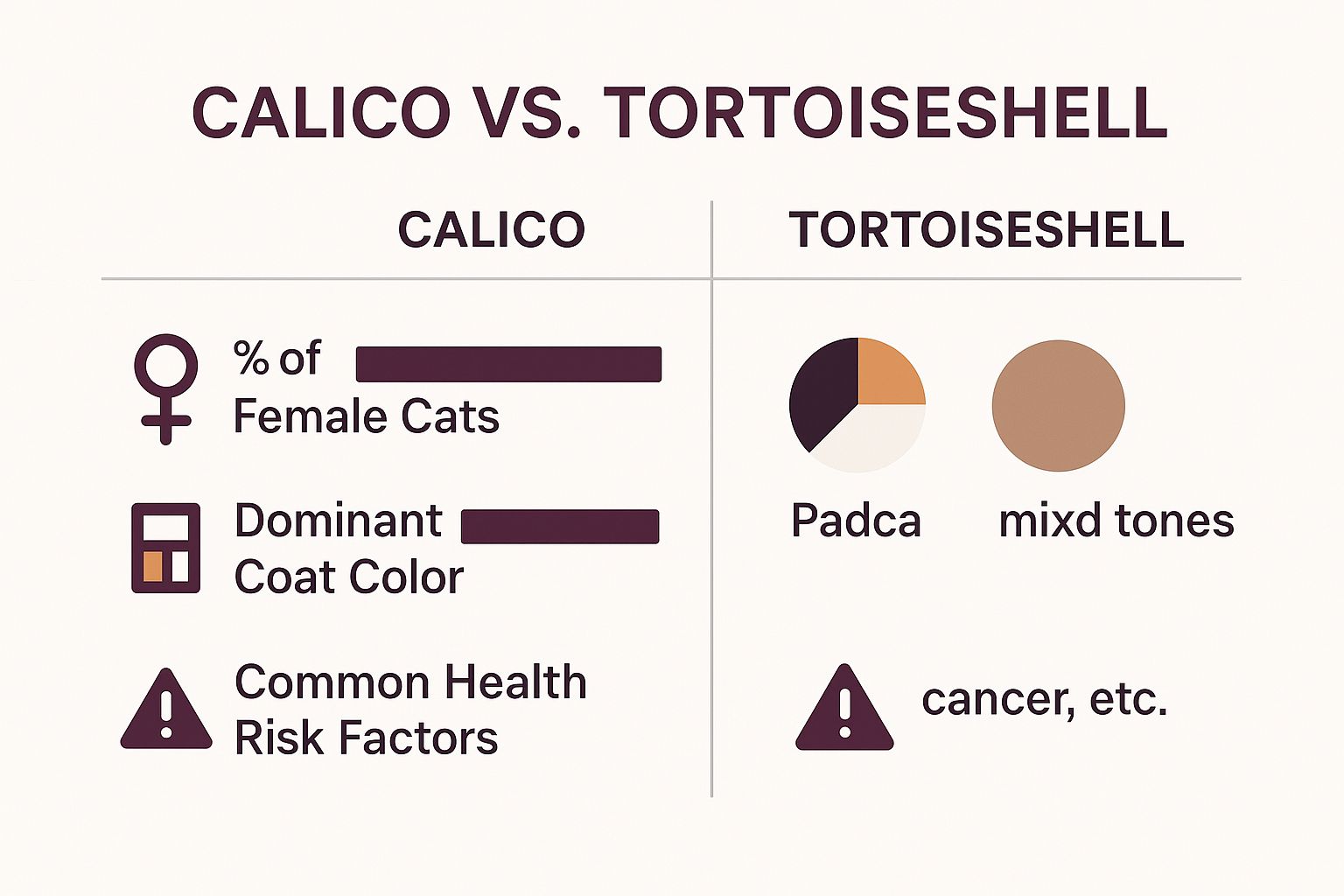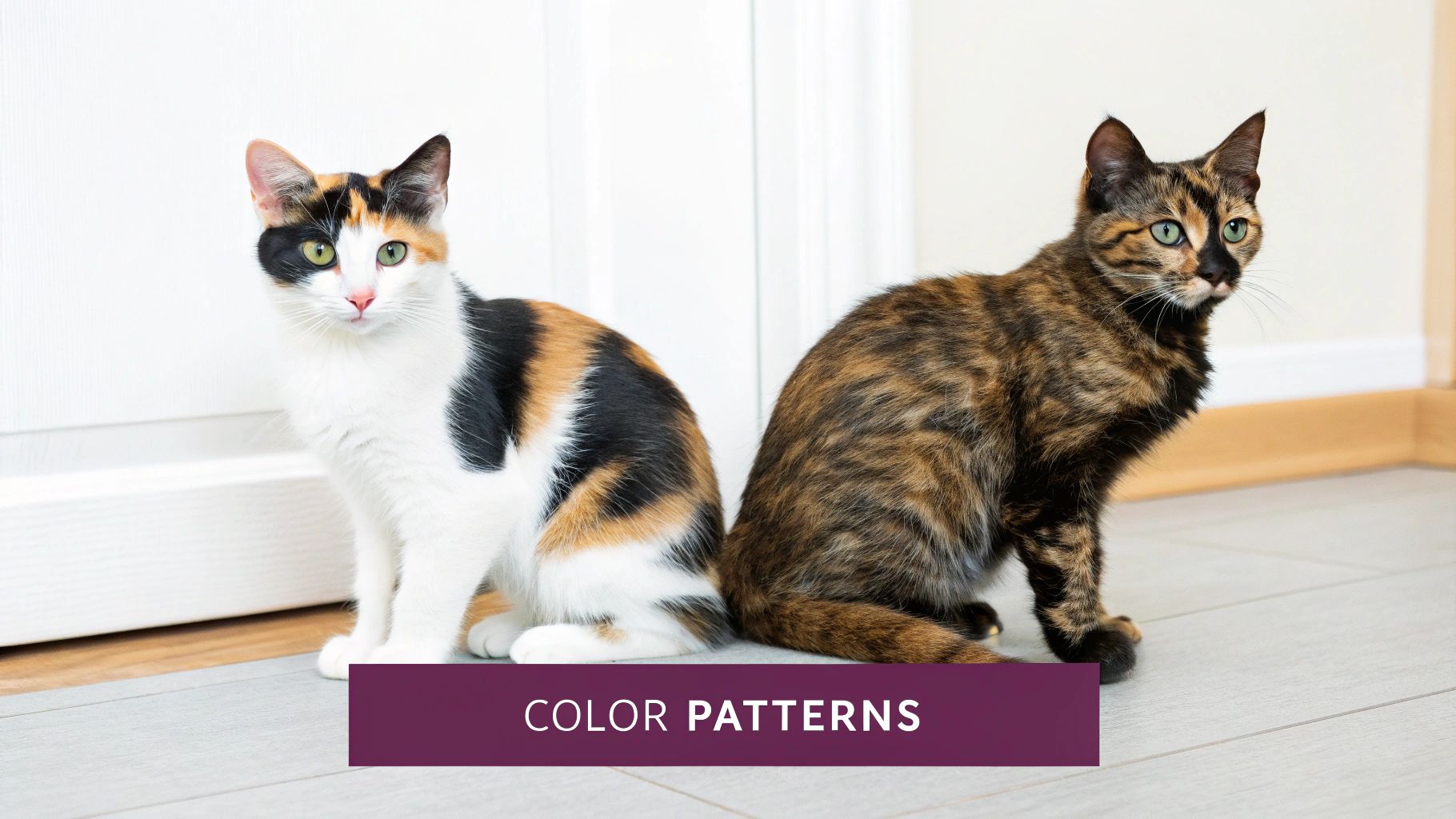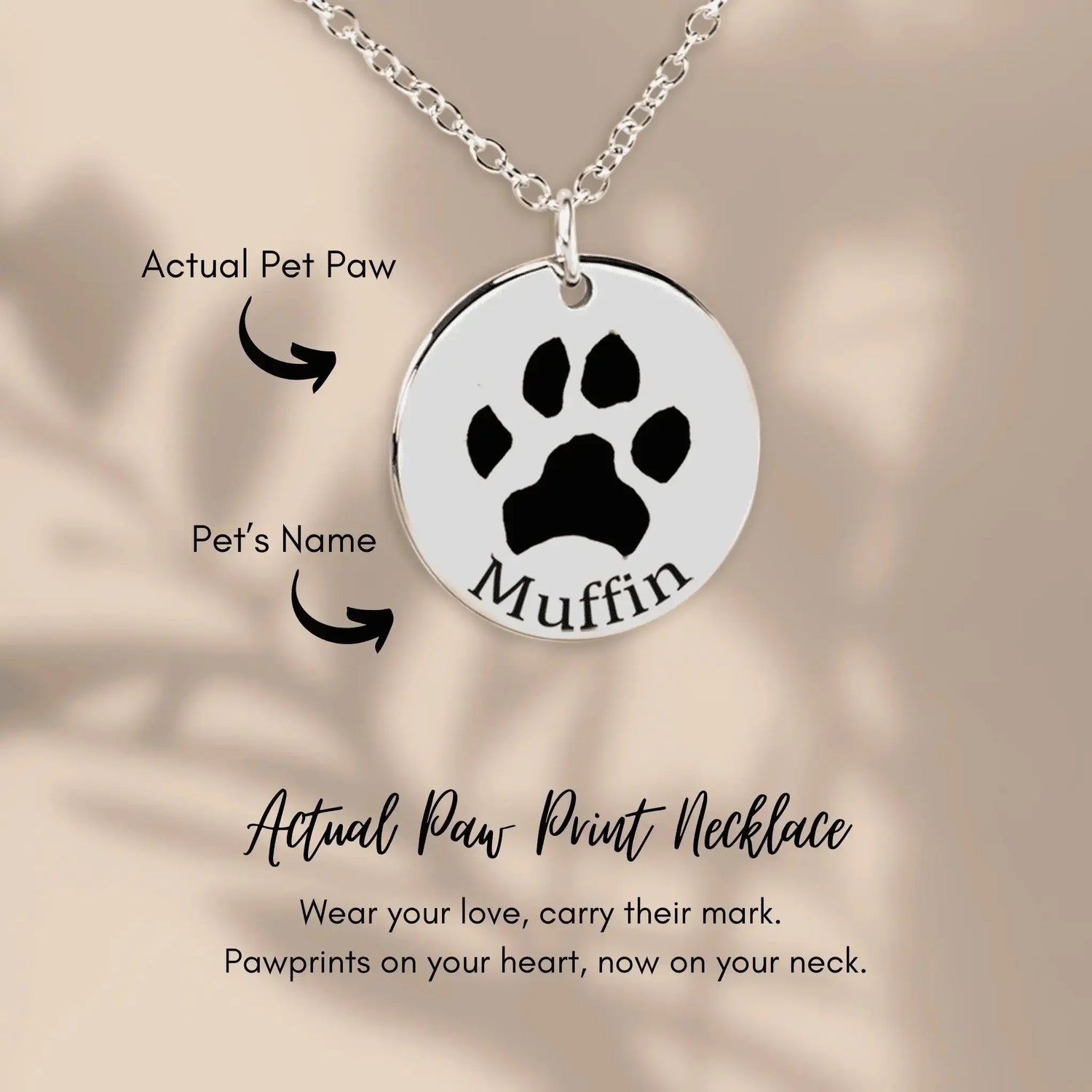Difference Between Calico and Tortoiseshell Cats: Key Differences

Welcome, cat lovers! 😻 Your pal Floofie is here to help you crack one of the most colorful codes in the feline world. So, what’s the difference between calico and tortoiseshell cats? It all boils down to one simple thing: white fur.
A calico cat will always have large, distinct patches of white. On the other hand, a tortoiseshell (or "tortie") has a beautiful, blended coat of two colors with very little to no white at all. It's that easy! ✨
Your Quick Guide to Calico and Tortoiseshell Coats
Have you ever spotted a gorgeous multi-colored kitty and felt stumped trying to figure out if it was a calico or a tortie? You’re definitely not alone! It's one of the most common mix-ups for cat enthusiasts. Our mascot Floofie says it happens all the time!
Even though both boast stunning coats, that single clue—the presence of significant white fur—is your instant giveaway.
Think of it this way: a calico looks like it’s wearing a quilt made of colorful patches separated by big white squares. A tortie, however, looks like two paint colors were gently swirled together, creating a seamless, brindled mosaic. Once you see it, you can't unsee it! 😉
Calico vs Tortoiseshell At a Glance
To make spotting the difference even easier, Floofie has put together a handy little table. Think of it as your purr-fect cheat sheet for becoming a coat pattern expert!
| Key Feature | Calico Cats | Tortoiseshell Cats (Torties) |
|---|---|---|
| White Fur | Always present in large, distinct patches. | Little to no white; if present, it's minimal (e.g., paws). |
| Color Pattern | Separate, solid patches of color (like a map). | Blended, brindled, or mosaic pattern of colors. |
| Primary Colors | Orange, black, and white. | Orange and black (or their dilute versions). |
| Common Nickname | Sometimes called "tri-color cats." | Affectionately known as "torties." |
This table gives you a great snapshot, but what's going on behind the scenes? The genetic story is fascinating.
The core difference comes down to how their coat genes are expressed. While both get their classic orange and black colors from genes located on the X chromosome, calicos have an extra gene that causes white spotting. This gene is what creates those signature patches. You can dive deeper into their unique genetics over at the Merck Vet Manual.
This infographic breaks it down visually for you.

As you can see, it all comes back to that coat pattern. Calicos have those clear, separate patches of color, while torties rock a more blended, swirled look. Now you'll be able to tell them apart in a flash!
Uncovering the Genetic Secrets of Their Coats

Ready for a quick science lesson, Floofie-style? 🔬 The incredible patterns on calico and tortoiseshell cats aren't just a happy accident—they're genetic masterpieces! The secret ingredient behind their colorful coats is the mighty X chromosome.
This is where all the magic happens. The gene that decides if a cat's fur will be orange or black is found only on the X chromosome. Because female cats have two X chromosomes (XX), they have the unique ability to carry the genetic instructions for both orange and black fur at the same time.
Male cats, on the other hand, have XY chromosomes, so they typically only get one of those colors. This is the simple reason why nearly every calico and tortie you'll ever meet is a girl! 💅
The Master Artist: X-Inactivation
So, if a female cat has one X chromosome for orange and another for black, why doesn't her fur just mix into a muddy brown? That's thanks to a truly fascinating process called X-inactivation.
When a female kitten is just a tiny embryo, her body starts randomly "turning off" one X chromosome in each and every cell. This process is completely random from one cell to the next, which creates that beautiful, unpredictable mosaic effect.
- If the X chromosome with the orange gene is left on, that patch of fur will grow in orange.
- If the X chromosome with the black gene stays active, that patch will be black.
- This random shutdown happens all over her body, resulting in a one-of-a-kind pattern for every single cat.
This biological wonder, also known as lyonization, was a mystery for a long time. While people have admired these cats for centuries, it wasn't until a scientist named Mary Lyon proposed the idea in 1961 that we really understood the genetics behind their coats. It’s this genetic dance that makes the difference between calicos and torties so special.
If you're curious about another amazing coat color, check out our guide on what breed an orange tabby cat is.
The White Spotting Gene: The Calico Difference
Now you're probably asking, "But what about the white fur on calicos?" This is the key genetic detail that separates them from torties.
While torties are a two-color creation of X-inactivation, calicos have an extra instruction in their genetic code. They have a totally separate gene known as the white spotting gene, or piebalding gene.
Key Takeaway: The white spotting gene is the defining genetic difference between calico and tortoiseshell cats. It overrides the color genes in certain areas, preventing pigment from forming and creating those signature clean, white patches.
This gene essentially acts like a stencil, masking the orange and black colors in big sections. Wherever this gene is active, you get white fur. Where it's not, the X-inactivation process takes over to create the colorful patches we know and love. Floofie thinks it’s the coolest biology lesson ever! 🐾
A Visual Tour of Calico and Tortie Patterns

Alright, let's get down to the fun part—learning how to spot the difference between these gorgeous cats in the wild (or, you know, on your couch 🛋️). Think of this as your official field guide to telling a calico from a tortie. Once you know what to look for, you'll be a pattern-spotting pro.
The biggest giveaway for a calico is their distinct, separate patches of color laid out against a white backdrop. It's all thanks to that white spotting gene we mentioned, which creates a look that is bold, clean, and impossible to miss.
Of course, not all calicos are created equal! They show up in a few beautiful variations you might see at your local shelter or strutting through the neighborhood.
Spotting a Calico in the Wild
When you’re trying to identify a calico, you're looking for that classic tri-color coat. The most common version is the traditional calico, which features bold, solid blocks of orange and black on a mostly white body. The high contrast is absolutely stunning!
But sometimes, genetics likes to get a little artistic. You might also come across a dilute calico.
A dilute calico rocks the same patched pattern, but the colors are much softer. That bold black becomes a gentle blue-gray, and the bright orange fades to a dreamy, pale cream, all still separated by crisp white.
It’s like looking at the same painting, just in beautiful pastel shades. No matter the intensity of the color, the key is always those well-defined patches on a white background.
The Beautiful Blends of a Tortoiseshell
Now, let's turn our attention to the mesmerizing mosaics that are tortoiseshell cats. Torties are all about the blend! Their coats are famous for having very little, if any, white fur. Instead, you get a gorgeous mix of black and orange woven together.
Their patterns can vary quite a bit, creating a few distinct looks:
- Brindled Tortie: This is the pattern you'll see most often. The black and orange are so closely mixed that they create a speckled or "brindled" effect all over. It looks like an artist swirled the two colors together on a brush.
- Patched Tortie: Sometimes, a tortie will have slightly larger splotches of color. These aren't separated by white like a calico's patches, but the orange and black areas are more distinct than the finely speckled brindled look.
- Chimera Tortie: In very rare and totally stunning cases, you might spot a chimera, where the two colors are split perfectly down the middle of the face! How cool is that?!
To keep those unique calico patches and tortie blends looking their absolute best, you need the right tool. Our Floofie Gentle Grooming Brush is purr-fect for maintaining a healthy, shiny coat without irritating your kitty's skin. It’s a must-have for every colorful cat's spa day! ✨
Do They Really Have 'Tortitude'
Let's get into the juicy stuff—the personalities! 😼 If you've spent any time around cat people, you've probably heard the legendary term 'tortitude' being whispered about. This word was lovingly coined to describe the unique personality often tied to tortoiseshell cats.
So, what is tortitude, exactly? Think of it as a special blend of sass, smarts, and spice. Tortie parents will often tell you their cats are incredibly vocal, fiercely loyal, and maybe just a little bit bossy. They know what they want, and they have no problem letting you know it, either!
The Sweet Side of Calicos
On the other side of the colorful spectrum are the calico cats. The common stereotype paints them as gentle, sweet-natured, and much more laid-back companions. People often describe them as being exceptionally affectionate and loving, perfectly content to be your sweet, tri-colored shadow.
Some think their calmer demeanor might be connected to the same "white spotting gene" that creates their patches. The theory is that this genetic trait also mellows out their personality, making them more easygoing than their tortie counterparts.
Floofie's Fun Fact: While there's no hard scientific proof linking coat color to personality, a UC Davis study did find that owners were more likely to report calicos and torties as having a bit more sass than other cats!
Every Cat Is a Unique Masterpiece
So, is there any truth to these stereotypes? While it's incredibly fun to speculate, the most important thing to remember is that every single cat is an individual. Just like our pal Floofie, their personality is shaped far more by their upbringing, environment, and unique experiences than by the color of their fur.
A cat's behavior is a complex mix of genetics and nurture. A relaxed, loving home can bring out the gentle side of any kitty, just as an early life of struggle might make them more cautious. Sometimes a cat's behavior, like showing their belly, can be misinterpreted. You can learn more about why cats show their belly and what it truly means.
Ultimately, whether your cat is a sassy tortie or a sweet-as-pie calico, they have a one-of-a-kind personality just waiting for you to discover. The best way to know the difference between calico and tortoiseshell cats is simply to spend time with them and appreciate all their individual quirks!
Whether your kitty is feisty or gentle, they all share one thing in common—a love for playtime! Bring out their inner hunter with our top-rated Interactive Feather Wand from the Floofie collection. It's guaranteed to get those paws moving and provide hours of fun for any personality type! 💖
Caring for Your Colorful Cat

A happy cat is a healthy cat—that's a motto our own mascot, Floofie, lives by! When you bring home a stunning calico or tortie, the great news is that their gorgeous coat doesn't come with any special health complications. Your focus can remain on the foundations of universal cat wellness: a great diet, lots of stimulating playtime, and consistent vet check-ups.
That said, the unique genetics that create these coats do introduce one fascinating health quirk. You've probably heard that almost all calico and tortoiseshell cats are female, and it’s completely true! An incredible 99.9% of these colorful cats are girls.
The rare exception is a male cat born with an extra X chromosome (an XXY configuration), a condition called Klinefelter syndrome. It's estimated that only about 1 in every 3,000 calico or tortoiseshell cats is male. These special boys are nearly always sterile and can sometimes face other related health challenges. For a deeper dive, cats.com breaks down the fascinating statistics behind these unique feline coats.
Nurturing a Vibrant Coat and Happy Kitty
For the lovely ladies—which will be the vast majority of these cats—care is refreshingly straightforward. Keeping that coat glossy and their energy up starts from the inside. A balanced diet packed with omega fatty acids will make those beautiful patches and mottled colors truly pop! ✨
Floofie’s secret weapon for a glowing coat is our amazing Salmon Oil Supplement. Just a few drops mixed into their food can do wonders for keeping their fur silky, smooth, and vibrant. Your colorful kitty will definitely thank you with some extra head boops.
Beyond nutrition, creating a safe and engaging home is key. A happy cat needs plenty of vertical space for climbing, cozy nooks for napping, and fun toys to stalk and hunt. For more great ideas on creating the ultimate feline paradise, check out our guide on how to cat-proof your home.
Key Insight: While their coat is just for show, a nutrient-rich diet and a safe, enriching environment are the cornerstones of your cat's health. Proper care lets their unique beauty shine from the inside out.
Common Breeds with These Coats
It's a common misconception, but "calico" and "tortoiseshell" are coat patterns, not cat breeds! This means you can find these stunning looks across many different types of cats, from purebreds to magnificent mixed-breed moggies. Of course, some breeds are more likely to show off these colorful coats than others.
Here's a quick look at some popular breeds where you'll often spot these gorgeous patterns.
Popular Breeds Featuring Calico & Tortoiseshell Coats
A quick look at common cat breeds where these beautiful and distinct coat patterns are frequently found.
| Breed Name | Commonly Features Calico | Commonly Features Tortoiseshell |
|---|---|---|
| American Shorthair | ✔️ | ✔️ |
| Japanese Bobtail | ✔️ | ✔️ |
| Maine Coon | ✔️ | ✔️ |
| Persian | ✔️ | ✔️ |
| Cornish Rex | ✔️ | ✔️ |
| Scottish Fold | ✔️ | ✔️ |
From the sturdy American Shorthair to the elegant Persian, these patterns add an extra layer of beauty to already wonderful breeds. So, whether your colorful companion is a purebred or a one-of-a-kind mix, their coat is a beautiful expression of their unique genetic makeup.
Finding Your Perfect Patchwork Companion
So, are you completely smitten with these colorful kitties yet? 😻 The best part of this whole adventure is figuring out which one belongs in your home. We've gone over the key difference between calico and tortoiseshell cats, but honestly, choosing a cat is always more about the connection you feel than the color of their coat.
Let's lean into the fun stereotypes for a second. Are you looking for a companion with that legendary "tortitude"—a cat who might be a little sassy, super chatty, and fiercely independent? Or does a gentle, sweet-natured, and more relaxed calico sound like the perfect addition to your life?
The Most Important Step
While it’s fun to play the guessing game based on their fur, the absolute best way to find your new best friend is to meet them in person. Every single cat is an individual, and their real personality truly comes out when you're face-to-face. Floofie and I can't say this enough: visit your local animal shelter or rescue!
Your perfect patchwork companion is waiting for you right now, and what really matters is their spirit. You might find a spunky calico or a total cuddlebug tortie—you just won't know until you say hello! The right cat will choose you right back.
The ultimate truth is that personality trumps pattern every single time. Open your heart and home to a rescue, and you'll find a love that’s more beautiful than any coat color.
Once you’ve found your perfect patchwork pal, a custom pet portrait canvas is a beautiful way to celebrate their unique look and forever capture that special bond.
To help welcome your new family member and get you started on the right paw, Floofie has a special treat for you! Use code NEWKITTY15 at checkout for 15% off our 'New Cat Welcome Kit' from the Floofie store! 🎉
Your Calico and Tortoiseshell Questions Answered
Still curious about these colorful kitties? Don't worry, Floofie's got our detective hats on to clear up any lingering confusion! 🐾 We gathered the most common questions cat parents have to make you the ultimate expert on the difference between calico and tortoiseshell cats.
Let's dive right in and tackle some of the biggest head-scratchers. By the end, you'll be spotting these feline masterpieces like a seasoned pro.
Are All Calico and Tortoiseshell Cats Female?
Pretty much! A whopping 99.9% of them are girls. The reason is pure science—the genes responsible for orange and black fur are located on the X chromosome. To show off both colors at once, a cat needs two X chromosomes, which is the standard genetic makeup for females (XX).
But what about the boys? About 1 in 3,000 calico or tortoiseshell cats is male. This happens because of a rare genetic condition called Klinefelter syndrome, where the cat has an extra X chromosome (XXY). So, while male torties and calicos are incredibly rare, they do exist!
Can a Cat Be Both a Calico and a Tabby?
Absolutely! 😻 When a calico or tortie also sports tabby stripes within their colored patches, you've got a "caliby" or a "torbie." It’s truly the best of both worlds!
You can spot them by looking for the classic tabby "M" marking on their forehead. You might also see faint stripes on their legs and tail running through the orange or black sections of their coat.
Do Calico and Tortoiseshell Cats Have Different Lifespans?
Nope! Their beautiful coat pattern has no direct impact on how long they live. A female calico or tortie has the same average lifespan as any other domestic cat, which is typically 12-16 years and often even longer with great care.
Their health and longevity really come down to the universal cat essentials: a nutritious diet, a safe and stimulating home, and lots of love. Male calicos and torties, however, may face health issues linked to their genetic condition that could potentially affect their lifespan.
No matter what questions you have, FloofChonk has the purr-fect products to keep your colorful companion happy and healthy. From stimulating toys to cozy beds, we have everything you need to celebrate your unique kitty! Check out our full collection at our online store.

